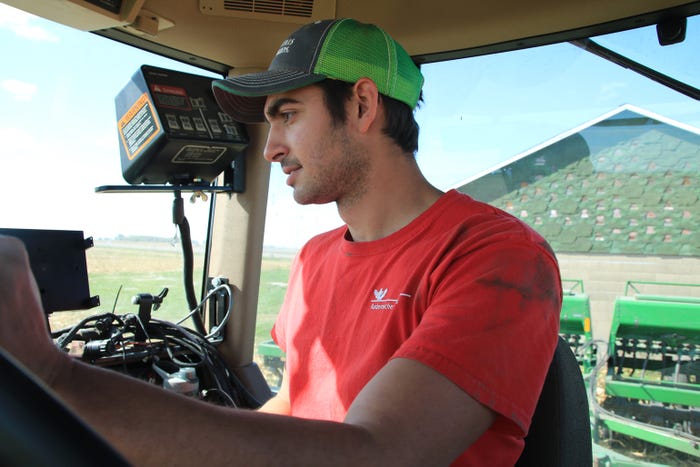
Seed drills are none too common in the heart of Illinois, where high land values make it difficult to justify planting wheat over a cash crop that fetches more dollars per acre in the area’s high-quality soil. And hardly anyone drills beans anymore, including Rademacher Farms in Gifford, Ill. But the drill is making a comeback on this farm and throughout central Illinois.
Three years ago, Frank Rademacher and his father, Eric, converted their 570-acre operation to a no-till system with cover crops. They’ve gone to a rotation where they drill wheat every five years with two 15-foot John Deere 750 no-till drills pulled side by side using an aftermarket hitch. After wheat harvest, they follow up by drilling a grass and legume cover crop mix in July. After corn and soybean harvest, they drill cereal rye and other overwintering covers.
The strategy eliminates tillage and has, in part, helped the Rademachers increase profit by at least $100 an acre compared to eight years ago, when they were working ground. At that point, they were starting to experiment with the new system on their poorest-quality acres.
“The thought was, if we can make it work on the poorest soil, well heck, making it work on the good soil should be easy,” Frank Rademacher says. “It went well, so the next year we did a little bit more, and then the year after that, we did a little more, too.
“We flew cover crops on, and we rented a drill from the local soil and water conservation district. When we started with wheat three years ago and really got serious with cover crops, it just seemed like a good investment to buy a drill.” He says aerial coverage for cover crops was spotty, and drilling has a greater impact on fighting weeds.
Once he and his father saw how cover crops could successfully replace tillage on their lower-quality ground, they eventually expanded the no-till, cover-cropped system to the whole farm.
Lowering input costs
2019 was the first year the Rademachers were able to cut the number of corn herbicide passes down to one, at planting.
Rademacher says the $20- to $30-per-acre investment in cover crops made it so there wasn’t a noticeable yield impact for their no-till corn crop, and cover crops lying flat on the ground helped prevent weed seed germination following the killing spray. Adjusting fertilizer plans to frontload more nitrogen helped make sure there was plenty of N for the corn despite competition from decomposing cover crop residue.
“We put on 60% of our liquid N fertilizer with the planter upfront, and then we come through later to sidedress,” Rademacher says. “With no-till and cover crops, you want that nitrogen there at planting, because you don’t want to have tie-up issues. Especially with cereal rye — it likes nitrogen, and it sucks it up pretty easily.”

EQUIP: Frank Rademacher finished planting cover crops on Oct. 25 with two 15-foot John Deere 750 no-till drills pulled side by side using an aftermarket hitch.

He says weed control in soybeans is hard even in a good year, especially since they’ve transitioned to non-GMO beans. While they sprayed ahead of planting beans this year, next year, they’ll use a roller crimper to roll down 4- to 5-foot cereal rye and crimp the stalks — creating a mat of dead straw. This is a technique used by organic growers that the Rademachers hope will eventually reduce or eliminate herbicides on bean acres.
“When Dad started getting involved in the farm, we had three tractors. We’re down to one now,” Rademacher says. “We don’t need a big tillage tractor; we don’t need a field cultivator or a ripper. When you think about the kind of money that’s tied up in equipment like that for people, we’re talking hundreds of thousands of dollars in equipment, plus manpower.”
Testing the waters
While making the transition to the five-year wheat, soybean and corn rotation, Rademacher recalls one field where they had to plant beans after beans. The white mold pressure was high, so they planted cereal rye between the growing seasons and left one strip without. Cereal rye suppresses white mold, and he saw yield drop by about 20 bushels in the non-covered strip.
The Rademachers also have experimented with seed treatments to see if they’re worth the investment in their new cover crop system. Among six trials, there was less-than-1-bushel difference in yield between treated and untreated corn in 2019. In soybeans, three 50-acre side-by-sides plots of treated vs. untreated seed also didn’t show any yield differences, despite planting into wet conditions. Insect pressure was even higher than usual since it was one of the only emerged soybean fields in the area for several weeks.
“Based on that, I would say we’re done with seed treatment in beans,” Rademacher says.
When asked when more farmers in agriculture will pick up no-tilling and cover cropping, he says he already drilled cover crops ahead of 2019’s growing season for curious neighboring growers. The Rademachers plan to plant 40 acres of cereal rye for seed to sell locally next year, and they see potential for more seed drills in central Illinois.
“The biggest struggle with anything like this is everyone is afraid of, ‘Well what are the neighbors doing?’ That doesn’t matter,” Rademacher says. “Maximizing profit while minimizing our environmental impact — that’s what matters. Our neighbors are interested, which is great. We love to see it, and we’re excited to see where this goes.”
About the Author(s)
You May Also Like




